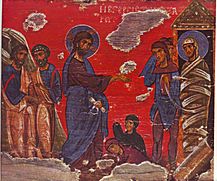Lazarus of Bethany facts for kids
Quick facts for kids SaintLazarus of Bethany |
|
|---|---|

Christ's raising of Lazarus, Athens, 12–13th century
|
|
| Four-days dead, friend of Christ | |
| Venerated in | Eastern Orthodox Church Oriental Orthodox Church Roman Catholic Church Eastern Catholic Churches Anglican Communion Lutheran Church Islam |
| Feast |
|
| Attributes | Sometimes vested as an apostle, sometimes as a bishop. In the scene of his resurrection, he is portrayed tightly bound in mummified clothes, which resemble swaddling bands. |
Lazarus of Bethany, also known as Saint Lazarus, is a very important figure in the Gospel of John. This is one of the books in the Christian Bible. He is famous because Jesus brought him back to life. This happened four days after Lazarus had died.
Many Christian groups, like the Eastern Orthodox Church and the Catholic Church, honor Lazarus. They have different stories about what happened to him later in his life.
Contents
The Story of Lazarus
The most famous story about Lazarus is in the Gospel of John. It tells how Jesus brought him back to life. This event is seen as a very powerful sign. It shows Jesus's power over death.
Lazarus's Sickness and Death
Lazarus lived in a town called Bethany. This town is now known as Al-Eizariya. Its name means "the place of Lazarus." Lazarus had two sisters, Mary and Martha.
One day, Lazarus became very sick. His sisters sent a message to Jesus. They hoped Jesus would come and heal him. Jesus was not in Bethany at that time. He waited two more days before traveling there.
By the time Jesus arrived, Lazarus had already died. He had been in the tomb for four days. Martha met Jesus first. She told him that if he had been there, her brother would not have died.
Jesus Raises Lazarus
Jesus told Martha, "Your brother will rise again." He then went to the tomb. It was a cave with a stone covering the entrance. Jesus asked for the stone to be moved.
Martha was worried because Lazarus had been dead for so long. Jesus told her, "Did I not tell you that if you believe, you will see the glory of God?" The stone was moved.
Jesus then prayed to God. He called out in a loud voice, "Lazarus, come out!" And Lazarus came out of the tomb. He was still wrapped in his burial cloths. Jesus told the people to unwrap him and let him go.
This amazing event showed Jesus's power. It was a very important miracle. Many people who saw it believed in Jesus.
Another Lazarus in the Bible
There is another person named Lazarus in the Bible. He is mentioned in the Gospel of Luke. This Lazarus is part of a story Jesus told. It is called the parable of the Rich Man and Lazarus.
In this story, Lazarus is a poor man. He sits at the gate of a rich man's house. He hopes to get scraps of food. Both men die. The poor Lazarus goes to heaven. The rich man goes to a place of suffering.
Even though they have the same name, these two Lazaruses are usually seen as different people. The Lazarus from Bethany was brought back to life. The Lazarus in the parable was a character in a story.
Lazarus in Culture
The name Lazarus is often used in everyday language. It refers to something that seems to come back to life. For example, in science, a "Lazarus taxon" is a group of living things. They seem to disappear from the fossil record. Then, they reappear later. It's like they came back from being extinct.
You might also hear the name Lazarus in books, movies, or songs. It's a way to talk about things that are revived or brought back.
Images for kids
-
The Raising of Lazarus, by Duccio, 1310–11
-
Sixth-century mosaic of the Raising of Lazarus, church of Sant'Apollinare Nuovo, Ravenna, Italy.
-
The Raising of Lazarus, Oil on canvas, c. 1517–1519, Sebastiano del Piombo (National Gallery, London)
-
Autun Cathedral (Cathédrale Saint-Lazare d'Autun), Autun, France, also said to be built over the tomb of Lazarus
-
The Resurrection of Lazarus, Byzantine icon, late 14th – early 15th century, (From the Collection of G. Gamon-Gumun, Russian museum)
-
The Resurrection of Lazarus, Russian icon, 15th century, Novgorod school (State Russian Museum, Saint Petersburg)
-
The Raising of Lazarus, Oil on canvas, c. 1517–1519, Sebastiano del Piombo (National Gallery, London)
-
The Raising of Lazarus, Oil on canvas, c. 1609, Michelangelo Merisi da Caravaggio (Museo Regionale, Messina)
-
The Raising of Lazarus, 1630–1631, Rembrandt van Rijn (Los Angeles County Museum of Art, Los Angeles)
-
The Raising of Lazarus, 1540–1545, Giuseppe Salviati
-
The Raising of Lazarus (after Rembrandt), Oil on paper, 1890, Vincent van Gogh (Van Gogh Museum, Amsterdam)
-
Raising Lazarus, Oil on Copper Plate, 1875, Carl Heinrich Bloch (Hope Gallery, Salt Lake City)
-
The Raising of Lazarus, 1800, William Blake, Aberdeen Art Gallery
See also
 In Spanish: Lázaro de Betania para niños
In Spanish: Lázaro de Betania para niños

















